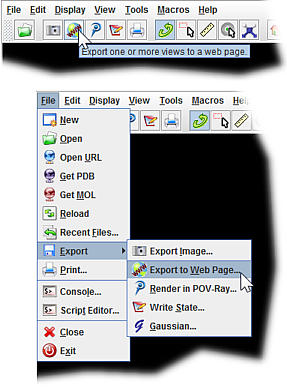

# should be called prior to jmolApplet() and should incorporate some sort of # allows control over the sync ID via javascript. # new Jmol.js feature: jmolGetSyncId() jmolSetSyncId(id) # sync jmolApplet2 OFF # turns sync off for an applet ON A DIFFERENT PAGE # sync > "set echo top left echo OK" # sends OK to top left of all OTHER applets
#Jmol script commands drivers#
# sync jmolApplet1 #syncs this applet with jmolApplet1 both as drivers # sync * # synchronize all applets as drivers # (optional) a unique string of digits - brackets included org/jmol/console/ScriptEditor.java:107 msgid Jmol Script Editor msgstr. bug fix: command-line jmol scripts not exiting jmol upon an error.
#Jmol script commands update#
This feature is important for cross-frame synchronization only. bug fix: jmol -ionxs with a script that includes measurement tries to update a. # syncId is not given, then the ID for the page containing the controlling applet # number that identifies the page containing the controlling applet. # along with an optional bracketed sync group identifier - generally a random # Applets are identified by appletId (jmolApplet0, for instance) # other applets directly, without the intervention of JavaScript.

# In addition, the sync command allows ANY command to be sent to one or more Move one with the mouse, and the other moves as well. # The sync command allows two or more applets to be synchronized in # new feature: synchronization of applets using Jmol scripts: For example, from Applet A's console, type: Simply indicate the target applet as a second parameter to the script command. This operation is independent of the state of sync being ON or OFF.Īlso new in Jmol 11.6, you can use the Jmol math script() function to get information from another applet. Starting with Jmol 11.6, you can also use the script command with the APPLET option to send scripts to one or more applets. The command line for text starts with ' set echo'. It is possible to write commands, to display lines of text on the Jmol panel. Note the change in the size of the atoms. In addition, you can specify the applet by its extension, "A" or "B", or by its full name, "jmolAppletA" or "jmolAppletB" in this case. For example, type cpk 20 and press Enter. Other options include "*" (all synchronized applets)Īnd "." (only this applet, if it is synchronized). The ">" means "all other synchronized applets". Which would cause only the applet on the top to do the controlling, but allowed the bottom applet to be moved independently of that control.Īlso, if you open a console on one, you can give commands to the other using something like: Var s = (syncing ? 'sync * on sync * "set syncMouse true"': 'sync * off') Var syncing = document.getElementById("drive").checked Once the checkbox is checked, going to either one controls the other. Jmol provides a very rich set of scripting commands to select individual atoms or groups of atoms.
.The two applets are jmolAppletA and jmolAppletB. JSmol accepts all the same commands as Jmol, but setting up a webpage.
#Jmol script commands how to#
This page demonstrates how to synchronize applets in Jmol.


 0 kommentar(er)
0 kommentar(er)
